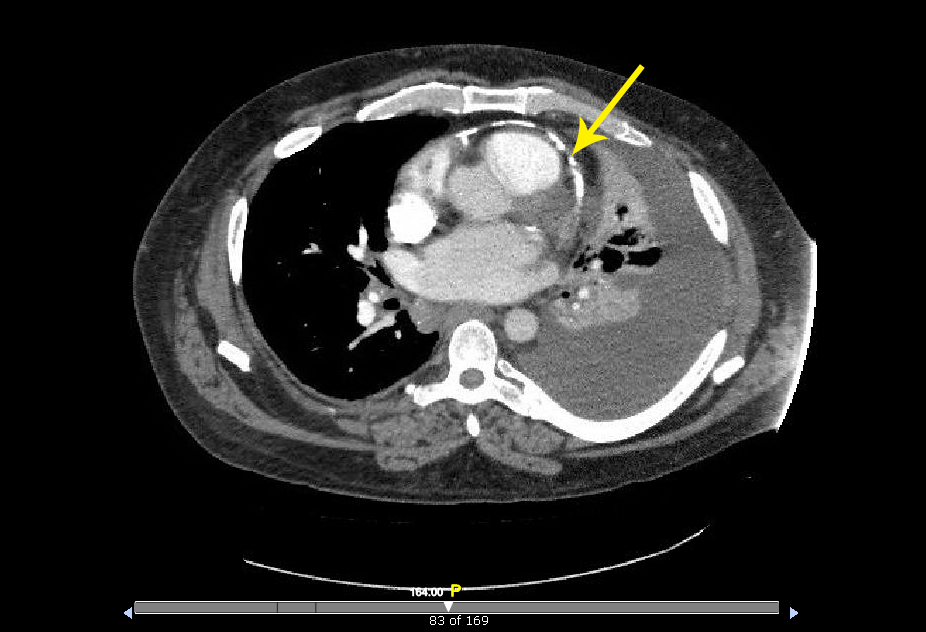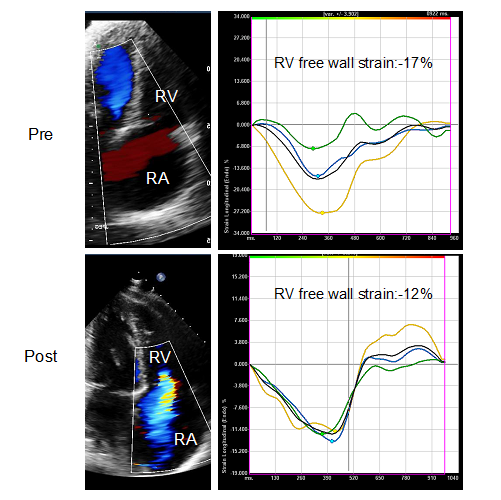A 54-year-old Caucasian man presented with worsening dyspnea on exertion, anasarca and a previous computed tomography (CT) chest scan showing calcification around the heart as shown in figure 1. History was significant for acute pericarditis 15 years ago, hypertension and sleep apnea. Echocardiogram and cardiac magnetic resonance imaging confirmed constrictive pericarditis (CP) with normal left ventricular and valvular function. Catheterization showed diastolic equalization of pressures, dip and plateau pattern of right and left ventricular pressures, and a systolic area index of 1.38. He underwent phrenic to phrenic resection of the pericardium. Intraoperatively he had extensive pericardial adhesions and severe calcifications.
Figure 1
CT chest scan with contrast. Yellow arrow showing pericardial calcification. CT = computed tomography
Patient was discharged home after successful post-operative recovery but continued to require diuretics. He returned to clinic with recurrent symptoms of right heart failure (HF) with ascites, pedal edema, and new atrial flutter. Figure 2 is a comparison of echocardiograms pre- and post- operatively, 4 weeks apart.
Figure 2
Worsening RV free wall strain measured with 2D speckle tracking showing a decrease from 17% to 12% post-operatively. RV = right ventricular
The correct answer is: A. Recurrence of CP.
On post-operative echocardiogram, the patient was noted to have a worsening RV systolic function requiring inotropic support, wo rsening mitral regurgitation and new 2+ tricuspid regurgitation (TR). He was discharged on torsemide 20 mg and spironolactone 50 mg. He was seen in clinic a month later with persistent fluid overload and atrial flutter. An echocardiogram showed 3+ TR, moderately decreased RV function, severely dilated left atrial cavity. 5 months later he continued to have 3+ TR with worsening RV function as shown in figure 2 with decreased RV free wall strain and severe TR. This case highlights the changes in LV/RV geometry post pericardiectomy when a thick, hardened, calcific shell that holds the heart chambers in a specific shape is distorted, leading to dilation of chamber size and subsequent dilation of the valvular annulus. Incidence of post pericardiectomy worsening of tricuspid regurgitation was 18% in our single center experience.
References
- Johnson TL, Bauman WB, Josephson RA. Worsening tricuspid regurgitation following pericardiectomy for constrictive pericarditis. Chest 1993;104:79-81.
- Taguchi S, Ishida O, Mori A, Suzuki R. Pericardiectomy for constrictive pericarditis with postoperative increase of tricuspid regurgitation. Cardio Vasc Syst 2013;1:9.


